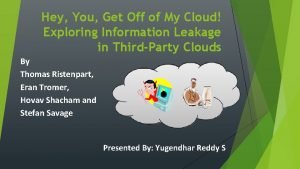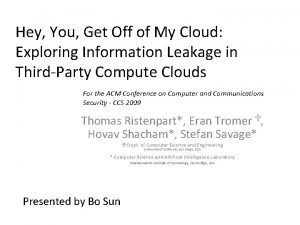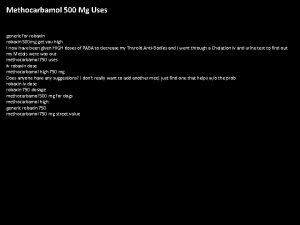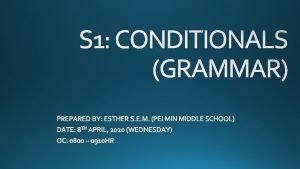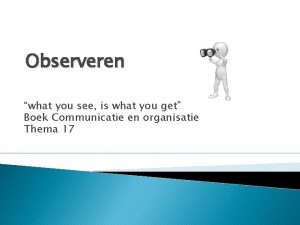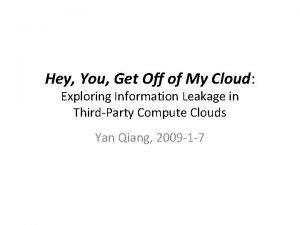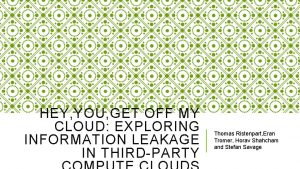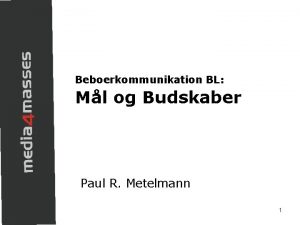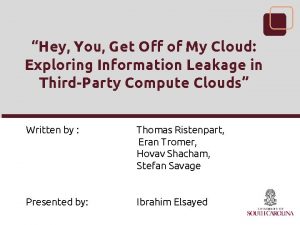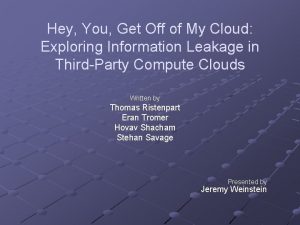Hey You Get Off of My Cloud Exploring




























- Slides: 28

Hey, You, Get Off of My Cloud: Exploring Information Leakage in Third-Party Compute Clouds For the ACM Conference on Computer and Communications Security - CCS 2009 Thomas Ristenpart*, Eran Tromer , Hovav Shacham*, Stefan Savage* Dept. of Computer Science and Engineering University of California, San Diego, USA * Computer Science and Artificial Intelligence Laboratory Massachusetts Institute of Technology, Cambridge, USA Presented by Bo Sun

Acknowledgement • Paraphrasing of titular authors and using their figures • Quotes from Amazon and Microsoft webpages – http: //aws. amazon. com/ec 2/ – http: //microsoft. com/Cloud/Windows. Azure • Clip art from Microsoft Office – http: //office. microsoft. com/en-us/images

Outline • Compute Cloud Services • Motivation & Goal • Procedure – Amazon EC 2 vulnerability • Contribution • Weakness • Improvement

Compute Cloud • Client wishes to rent a remote computer resource • Compute Cloud – Provider grants a virtualized resource – Many to one (client : physical resource) – Clients share the physical resource

Compute Cloud (User’s Perspective) • From Amazon’s EC 2 website – “quickly scale capacity, both up and down” – “pay only for capacity that you actually use” – “failure resilient applications” • From MS’s Azure website – “launch [webapps] in minutes instead of months” – “unencumbered by redundancy, bandwidth or server constraints”

Compute Cloud (Provider’s Perspective) • Efficient & Cheap – Maximize usage of physical resources • Provides for Users’ Needs – Dynamic Provisioning – Ease of deployment via Virtualization – Ease of backup • So what is bad about it? – VMs have their own vulnerabilities!

Multiplexing Tenancy (Co-residence) • Multiple “tenants”, single physical server – Works well if no user is malicious John Doe’s Virtual Machine Physical Server Bob’s Virtual Machine Trudy’s Virtual Machine

Problem • Trudy is Bob’s Adversary – Breaks data isolation between users – Violates Confidentiality John Doe’s Virtual Machine Physical Server Bob’s Virtual Machine Trudy’s Virtual Machine

Motivation & Goal • Motivation – Authors fear the compromise of confidentiality within compute clouds • Medical records, e-commerce (credit cards), etc. • Goal – Prove the existence of confidentiality breach within EC 2 – Suggest countermeasures

Procedure Overview • Placement – Placing adversary’s VM on the physical machine which hosts the victim’s VM • Attacker-Victim VM Co-residence Strategy – Proving Co-residence • Extraction – Culling confidential information • Via “Manipulation of shared physical resource” • “Information Leakage” • Side channel Attacks

Amazon EC 2 (Elastic Compute Cloud) • Uses XEN Virtual Machine Monitor • Each account can run 20 VM instances • VMs have access to many network probing tools – WHOIS, hping, nmap, wget – Arbitrary attack code which attacks other guest OS (VM instances)

Amazon EC 2 options • Region – Europe or US • Zone – Locales which are power-grid isolated – 3 Zones available • Configuration – Virtual Machine specs • RAM, CPU, etc. • Windows, linux, Free. BSD, etc.

Cloud Mapping • Map EC 2 – To find any patterns • Surveying External Addresses (WHOIS) – Three distinct IPs prefixed with /17, /18, /19 • 57344 IPs • Internal Addresses – DNS lookup within EC 2 mapped external/internal IPs • 14054 IPs with open port 80, 443

Mapping Continued… • Note coarse clustering

Mapping Significance • Showed that internal IPs were assigned correlates with zone and VM type • Such patterns can be exploited to ensure maximum likelihood of Co-residence • Prevention of mapping – Remove clustering based on zone & VM type – Make it harder to map external/internal IPs • VLANs and bridging

Co-residence Proof • Matching Dom 0 IP – Special-privileged “first guest OS”, which manages routing of traffic to other guest VMs – Using two traceroute to identify • First hop = attacker instance’s Dom 0 IP • Last hop = victim instance’s Dom 0 IP – Done on a different physical machine

Co-residence Proof • Can also be inferred in other ways • Round trip times – Lower in Co-resident instances • Numerically close IPs within 7 – Only 8 VM instances on a physical machine

Co-residency Obfuscation • Dom 0 does not respond to traceroute • Do statically assign internal IPs • Non-network based checks still persist – Co-residence based on observing CPU load • PRIME+TRIGGER+PROBE • Estimate based on anticipated cache eviction – Observation of host CPU load after an attacker triggers heavy load in victim

Co-residency Strategy • Naïve – Infer likely victim zone & config type from cloud map – Spawn many instances within a time frame and hope for co-residency – Of 1686 victims, 141 successful co-residencies using 1785 attacker instances • 8. 4% coverage

Co-residency Strategy • Placement Locality Abuse • Instances created with small time-gap exhibit high chance of being on the same physical machine – Wait for a known victim instance to disappear – Then wait for it to appear again • Immediately spam attacker instances

Co-residency Strategy • Much better coverage using time locality • Time of day did not effect coverage

Anti-Placement Strategy • Authors suggest letting users control where their VM instances run • Users decide who to share hardware with • Users pay extra for loss of efficiency

On Leakage of Data • Just from Cache-correlated CPU load – Covertly monitor web traffic of victim – Estimate key-stroke timing • victim inputting SSH password becomes insecure • Other sophisticated attacks exist, but low risk – Cross-VM cryptographic attacks – Authors defers to references

Contribution • Identified security risk of EC 2 – Amazon will work harder to ensure security • Tied together exploits using – network base tools – CPU load estimation • Addressed legal, ethical concerns

Weakness • Authors suggest generalizability of their approach, but procedure is tailored-made for EC 2 • Cache-based covert communication is a digression • Published information that might be useful for EC 2 rivals

Improvement / Extension • Do the same for MS Azure, or other service to ensure the claim that this approach is generalizable • Re-examine “fundamental” risk of resource sharing and come up with more clever solution

Thank you! • Questions?

References • Thomas Ristenpart, Eran Tromer, Hovav Shacham, and Stefan Savage. Hey, You, Get Off of My Cloud: Exploring Information Leakage in Third-Party Compute Clouds. Computer and Communications Security - CCS 2009
 Hey hey you you get off of my cloud
Hey hey you you get off of my cloud Hey hey you you get off of my cloud
Hey hey you you get off of my cloud Get in get on get off get out
Get in get on get off get out Song with hey hey in chorus
Song with hey hey in chorus Personification in one thing by one direction
Personification in one thing by one direction Hey bye bye
Hey bye bye Hey hey people
Hey hey people Laughing and a running hey hey
Laughing and a running hey hey Can you get high off methocarbamol
Can you get high off methocarbamol Smash mouth somebody once told me
Smash mouth somebody once told me Elbows off the table fingers off the food song
Elbows off the table fingers off the food song Drills for defensive lineman
Drills for defensive lineman The cleaner you are the dirtier you get
The cleaner you are the dirtier you get 1 2 3 conditionals
1 2 3 conditionals Vrije observatie
Vrije observatie What do you get when you cross darth vader with an elephant
What do you get when you cross darth vader with an elephant Get up get moving quiz
Get up get moving quiz Get up get moving quiz
Get up get moving quiz Get up get moving quiz
Get up get moving quiz Pseudocode for repetition
Pseudocode for repetition Get focused get results
Get focused get results Get up get moving quiz
Get up get moving quiz Hey you
Hey you Hey you
Hey you Beboerkommunikation
Beboerkommunikation Nice to meet you in spanish mucho gusto
Nice to meet you in spanish mucho gusto Nice to meet you in spanish mucho gusto
Nice to meet you in spanish mucho gusto Pods aggregation and silos in cloud computing
Pods aggregation and silos in cloud computing Cloud to cloud integration patterns
Cloud to cloud integration patterns
